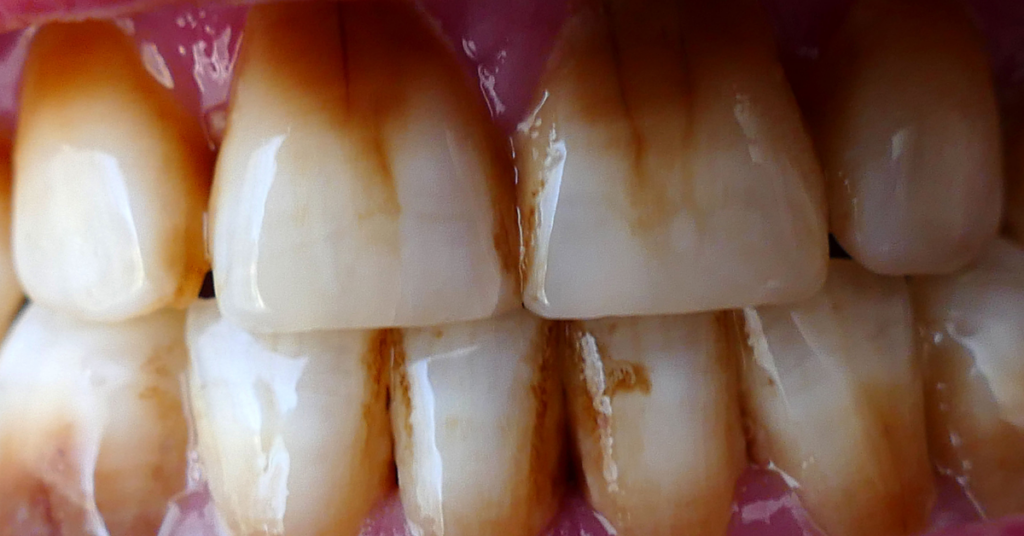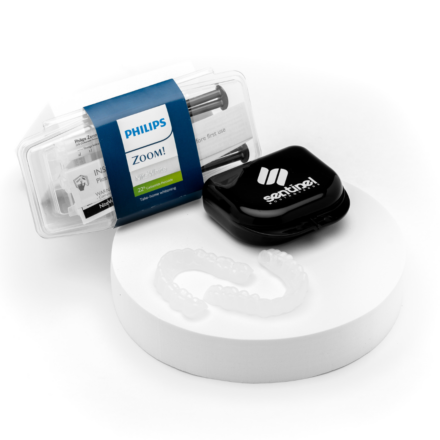Understanding the different types of teeth stains is pivotal in achieving optimal dental care and a radiant smile. The appearance of our teeth plays a significant role in our self-confidence and overall oral health.
In this comprehensive guide, we delve into the nuanced world of teeth stains, exploring various types, causes, and effective treatments. Whether caused by everyday habits, aging, or underlying medical conditions, a deeper understanding of these stains empowers individuals to make informed choices in their oral care routine. Join us as we explore the different types of teeth stains and the best strategies to maintain a vibrant, healthy smile.
Different Types of Teeth Stains
- Extrinsic Stains
- Caused by external factors like food, drinks, and tobacco
- Includes surface stains on the enamel
- Intrinsic Stains
- Result from internal factors like trauma or certain medications
- Occur within the tooth’s structure and can be challenging to remove
- Pigmented Stains
- Include various colorations like black and green stains
- Black stains often caused by bacterial accumulation
- Green stains attributed to poor oral hygiene or chromogenic bacteria
- Age-Related Stains
- Yellowing of teeth due to enamel thinning and dentin exposure
- Brown spots from pigmented foods, beverages, or tobacco use
- Medical Conditions and Stains
- Antibiotic-induced staining, presenting as dark bands on teeth
- Fluorosis, resulting in white or brown stains due to excessive fluoride intake during tooth formation

Surface Stains

Surface stains, often the most visible and easily acquired, come in two primary forms: extrinsic and intrinsic. Extrinsic stains result from external factors like certain foods, beverages, tobacco, and poor oral hygiene. These stains typically affect the enamel and can be addressed with preventive measures like regular brushing, professional cleanings, and avoiding stain-inducing substances. Intrinsic stains, on the other hand, develop within the tooth’s structure due to factors like trauma or certain medications during tooth development. Their removal can be more challenging, often requiring specialized dental treatments tailored to each individual case. Understanding the distinction between these surface stains is crucial in determining the most effective strategies for prevention and treatment, ultimately contributing to a brighter, stain-free smile.
Pigmented Stains
Pigmented stains introduce a spectrum of discoloration to teeth, with distinctive variations like black and green stains. Black stains, commonly caused by bacterial accumulation and frequently found in children, tend to appear as dark spots primarily along the gum line. While regular brushing helps manage these stains, professional dental cleanings remain crucial for their effective removal. Green stains, often attributed to factors like poor oral hygiene or chromogenic bacteria, manifest as greenish discoloration on teeth surfaces. Their treatment involves thorough dental cleanings and personalized oral care routines to prevent further discoloration. Understanding and promptly addressing pigmented stains not only restore dental aesthetics but also underscore the significance of proactive oral hygiene practices for maintaining pristine, healthy teeth.
Age-Related Stains

As time progresses, age-related stains start to manifest, altering the natural luster of our teeth. Among these, the most prevalent are yellowing and brown spots. Yellowing occurs due to the gradual thinning of enamel, exposing the dentin underneath, which naturally darkens with age. Factors like acidic foods, tobacco, and inadequate dental hygiene expedite this process. Brown spots, often stemming from pigmented foods or beverages, can also result from tobacco use. Managing these age-related stains involves a multifaceted approach, including regular dental check-ups, adopting enamel-strengthening oral care products, and, when necessary, professional whitening treatments or cosmetic procedures. Understanding these age-related discolorations enables individuals to proactively maintain their dental health, preserving the natural radiance of their smiles for years to come.
Medical Conditions and Their Impact on Teeth Stains
Medical conditions can significantly influence the appearance of teeth, often causing distinct and sometimes challenging stains. Conditions such as antibiotic-induced staining and fluorosis represent notable examples. Antibiotic-induced staining, commonly observed in children exposed to certain antibiotics during tooth development, leads to intrinsic discoloration, often presenting as dark bands on teeth. Fluorosis, stemming from excessive fluoride intake during tooth formation, results in white or brown stains on the enamel. Managing these conditions requires a tailored approach, involving professional dental intervention, personalized oral care regimens, and, in severe cases, cosmetic procedures. Recognizing the correlation between medical conditions and teeth stains underscores the importance of early diagnosis and proactive dental care in mitigating their impact on dental aesthetics and overall oral health.
How can I prevent these stains?
Preventing teeth stains involves adopting a proactive approach to oral hygiene and making lifestyle adjustments to minimize exposure to staining agents. Here are some effective preventive measures:
- Maintain Excellent Oral Hygiene: Brush your teeth at least twice daily using fluoride toothpaste and floss regularly. This helps remove plaque buildup, preventing stains from adhering to your teeth.
- Limit Stain-Causing Foods and Beverages: Reduce consumption of highly pigmented foods like berries, tomato sauce, and curries. Similarly, limit intake of beverages like coffee, tea, red wine, and soda, which can stain teeth.
- Use a Straw: When consuming stain-causing beverages, use a straw to minimize contact between the liquid and your teeth.
- Rinse or Brush After Eating: Rinse your mouth with water or brush your teeth after consuming foods or drinks known to cause stains. This helps remove stain-causing particles before they settle on teeth.
- Quit Tobacco Products: Tobacco, whether smoked or chewed, is a significant contributor to teeth stains. Quitting can prevent further discoloration and greatly improve oral health.
- Regular Dental Check-ups and Cleanings: Schedule routine dental visits for professional cleanings and check-ups. Your dentist can remove surface stains and identify any early signs of discoloration or dental issues.
- Consider Whitening Products: Discuss with your dentist about professional-grade whitening products or at-home kits that can help maintain teeth brightness. Ensure they’re used as directed to avoid enamel damage.
- Be Mindful of Oral Health Changes: Notice any changes in the color or appearance of your teeth. Address concerns promptly with your dentist to prevent potential complications or further staining.
Professional Treatments for Various Stains
When standard oral care routines fall short in addressing stubborn stains, professional dental treatments offer effective solutions tailored to diverse staining types. Dental practitioners employ an array of procedures catering to specific stain conditions. Teeth whitening procedures, ranging from in-office treatments to take-home kits, effectively target extrinsic discoloration, revitalizing the natural brightness of teeth. For more persistent or intrinsic stains, dental veneers emerge as a popular option, covering the front surface of teeth to mask discolorations. Bonding and contouring procedures allow for precise reshaping and color matching, ideal for addressing minor stains or imperfections. Consulting a dental professional aids in identifying the most suitable treatment, ensuring a personalized approach for achieving a flawless, radiant smile.
What is the average cost for teeth whitening services by a dentist?
The average cost for professional teeth whitening by a dentist can vary depending on several factors such as the method used, the dentist’s expertise, location, and the extent of discoloration. Here’s a general breakdown:
- In-office whitening: On average, in-office teeth whitening procedures can range from $300 to $1,000 per session. This method typically involves higher concentrations of whitening agents and is performed under professional supervision, resulting in immediate and noticeable results.
- Take-home kits: Dentists also offer take-home whitening kits with custom trays and professional-grade whitening gel. These kits might range from $100 to $400, depending on the dentist and the kit’s quality.
- Combo packages: Some dental practices offer combination packages that include both in-office treatments and take-home kits, which might cost between $500 to $1,500.
Can I purchase a professional teeth whitening kit online?
Yes! Discover a brighter, more confident smile with Sentinel Mouthguards‘ Teeth Whitening System—a professional-grade solution designed to elevate your smile from the comfort of home. Our innovative whitening kit offers the same caliber of results as costly in-office treatments, empowering you to achieve stunning results conveniently and affordably. Crafted by dental experts, our system combines cutting-edge technology with dentist-recommended ingredients to gently and effectively eliminate stubborn stains, restoring your teeth’s natural brilliance. With custom-fitted trays for personalized application and a powerful yet enamel-safe whitening gel, our system ensures even coverage and remarkable results in just a few applications. Transform your smile on your schedule with Sentinel Mouthguards’ Teeth Whitening System—experience professional-quality whitening without the hassle or expense of repeated dental visits.
-
Product on sale
 Teeth Whitening – Professional-Grade Results from the Comfort of HomeOriginal price was: $199.00.$179.00Current price is: $179.00.
Teeth Whitening – Professional-Grade Results from the Comfort of HomeOriginal price was: $199.00.$179.00Current price is: $179.00.
Can these stains indicate underlying dental issues?
Teeth stains can sometimes be an indication of underlying dental issues, although it’s not always the case. Here are a few scenarios where stains might point to broader dental concerns:
- Internal Staining: Intrinsic stains, which affect the inner structure of the tooth, could be caused by factors like trauma, certain medications, or excessive fluoride intake during tooth development. Sometimes, intrinsic staining might signify issues with the tooth’s development or internal damage, necessitating dental evaluation.
- Enamel Erosion: Stains that appear alongside enamel erosion or thinning might indicate a more significant problem. Enamel erosion can make teeth more susceptible to stains and can also be a sign of acid reflux, excessive consumption of acidic foods, or other digestive issues.
- Decay or Cavities: Stains in specific areas of the teeth, especially dark or brown spots, might indicate decay or cavities. These stains often develop as a result of bacterial growth and should be examined by a dentist to prevent further dental issues.
- Medical Conditions: Certain medical conditions like celiac disease or conditions that affect tooth development, such as amelogenesis imperfecta or dentinogenesis imperfecta, can cause distinct discolorations or abnormal tooth formations. Identifying these conditions early can lead to better management and care.
Conclusion
As we conclude our exploration into the diverse world of teeth stains, it becomes clear that understanding their various origins, manifestations, and treatments is pivotal in maintaining a radiant smile and optimal oral health. From extrinsic surface stains caused by everyday habits to intrinsic discolorations stemming from underlying medical conditions, each type presents unique challenges and requires tailored approaches for prevention and treatment. By adopting proactive oral hygiene practices, making mindful lifestyle choices, and considering professional treatments like Sentinel Mouthguards’ Teeth Whitening System, individuals can reclaim the natural brilliance of their smiles. Remember, while stains may differ in origin and intensity, the commitment to regular dental care and the guidance of dental professionals remain fundamental in preserving a healthy, vibrant smile. Embrace this knowledge to confidently navigate the realm of teeth stains and embark on a journey towards a brighter, more confident you.
Would you like to learn more about Sentinel Mouthguards products and services? Visit our help center today!

